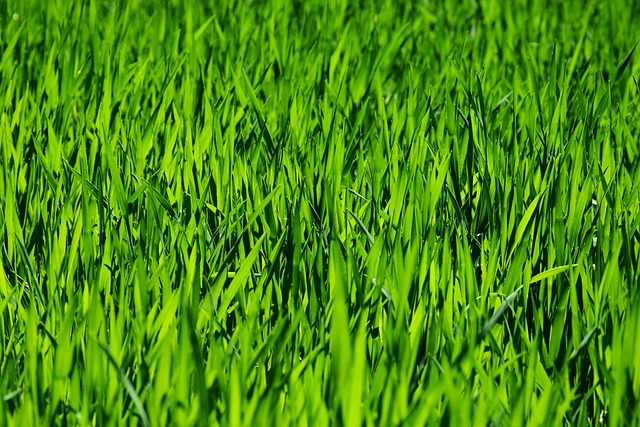Effective lawn care and landscaping hinges on a well-designed irrigation system that conserves water and promotes plant health. A reliable water source, integrated with filtration systems to prevent debris from compromising the system, is foundational. Pressure regulation and backflow preventers are crucial for maintaining water quality and integrity. Timers in controllers coordinate scheduled irrigation, while a network of pipes, emitters, sprinklers, and drip lines delivers precise water amounts to specific areas, catering to the unique needs of each plant. Advanced systems use moisture sensors and predictive weather data to minimize unnecessary irrigation, thus promoting sustainability. Regular system maintenance and strategic placement of components are essential for maintaining efficiency and longevity in supporting environmentally responsible lawn care practices. A well-maintained irrigation system is key to achieving a verdant lawn, which requires careful planning, tailored to your property's unique characteristics such as soil composition, vegetation types, and sunlight exposure. Seasonal adjustments and winterizing measures ensure the system functions optimally throughout the year, allowing for consistent, healthy lawn growth with minimal effort.
Effective lawn irrigation is pivotal in maintaining a lush, vibrant landscape. This article delves into the essentials of efficient irrigation systems, guiding homeowners through the installation process with a focus on residential applications. From comprehending the key components that make up a robust system to mastering the step-by-step setup for optimal landscaping, learn how to troubleshoot common issues and maintain your irrigation system for year-round green perfection. With insights into lawn care and landscaping, elevate your outdoor spaces with our comprehensive guide.
- Understanding the Components of Efficient Lawn Irrigation Systems
- Step-by-Step Guide to Installing a Residential Irrigation System for Optimal Landscaping
- Troubleshooting Common Issues and Maintaining Your Irrigation System for Lush Lawns Year-Round
Understanding the Components of Efficient Lawn Irrigation Systems

When implementing an efficient lawn irrigation system, it’s crucial to have a comprehensive understanding of its components. Efficient lawn care and landscaping rely heavily on the proper functioning of these systems to conserve water while ensuring that grass and plants receive adequate hydration. The core components include a water source, which can be a well, municipal supply, or rainwater harvesting system; a filter to remove debris and protect the irrigation system from clogging; a pressure regulator to ensure consistent water pressure; a backflow preventer to safeguard the drinking water supply; and a controller with a timer to manage when and how much water is released. The distribution system, which includes pipes, emitters, sprinklers, and drip lines, delivers water to each zone of the lawn or garden. Each emitter or sprinkler head is designed to deliver a precise amount of water, tailored to the specific needs of the plant it serves. To optimize performance, these systems can be equipped with moisture sensors that activate irrigation only when needed, based on soil moisture levels and weather forecasts. By selecting the right components and installing them correctly, lawn care and landscaping professionals can create an irrigation system that is both water-wise and effective at maintaining a healthy, vibrant landscape. Proper placement of these components and regular maintenance are key to ensuring the longevity and efficiency of the system, which in turn supports sustainable lawn care practices.
Step-by-Step Guide to Installing a Residential Irrigation System for Optimal Landscaping

To maintain a lush, thriving lawn, installing an efficient residential irrigation system is a pivotal step in your lawn care and landscaping efforts. Begin by assessing your property to determine the best water distribution approach, considering factors such as soil types, plant varieties, and sun exposure. This planning stage is crucial for tailoring the irrigation system to your specific landscape needs.
Once you’ve mapped out your plan, select the appropriate irrigation components, including drip lines for vegetable gardens or flower beds, sprinkler heads for expansive lawns, and a reliable water source for consistent supply. Follow these steps to install your new system:
1. Start by marking the layout of your irrigation system on the ground, ensuring even coverage and minimal waste. Install the mainline piping, using PVC or polyethylene pipes, depending on your preference and local regulations.
2. Connect the mainline to your water source, which may involve shut-off valves for maintenance access and pressure regulators to ensure a consistent flow to each zone.
3. Divide your yard into zones based on plant type and moisture needs. This zonal approach allows for precise watering and conserves water.
4. Place emitters or sprinkler heads according to the designated zones, burying them at appropriate depths for optimal coverage and minimal evaporation.
5. Install a controller with timers to automate your irrigation system, scheduling it to operate during off-peak hours to reduce water waste.
6. Test each zone manually to ensure proper function before activating the automatic timer settings. Adjust as necessary for even distribution and efficient operation.
7. Finally, backfill any trenches, replace sod or seed bare areas, and mulch around emitters to maintain soil moisture and prevent weeds.
By carefully planning and installing a residential irrigation system, you can enhance your lawn care and landscaping maintenance, promoting a healthy landscape with less effort and water usage.
Troubleshooting Common Issues and Maintaining Your Irrigation System for Lush Lawns Year-Round

When installing an irrigation system, ensuring it functions optimally is crucial for maintaining lush lawns year-round. Regular maintenance is key to preventing common issues that can arise. For instance, clogged sprinkler heads can be addressed by gently clearing debris or flushing the heads with water. If your system isn’t distributing water evenly, check for damaged pipes or improperly functioning valves and repair them promptly. Monitoring the system for leaks is also essential; a drip here and there can quickly add up to significant water waste. Landscaping elements like trees and shrubs can obstruct sprinkler coverage, so adjust spray patterns accordingly. During the colder months, take the necessary steps to winterize your irrigation system to protect it from freeze-related damage. This involves draining pipes and removing any components that reside above ground. By conducting routine checks and timely repairs, your irrigation system will efficiently water your lawn, promoting healthy growth throughout the seasons. Engaging in consistent lawn care practices complements a well-maintained irrigation system, ensuring your landscape thrives with minimal effort and maximum efficiency.
Effective lawn irrigation systems are a cornerstone of healthy, lush landscapes. By understanding the components that make up an efficient system, homeowners can navigate the installation process with confidence, as detailed in our step-by-step guide. Regular maintenance and timely troubleshooting of common issues are crucial for long-term success. Homeowners who apply these strategies will reap the rewards of a beautifully maintained lawn, which is both aesthetically pleasing and environmentally responsible. For comprehensive lawn care and landscaping solutions, ensuring your irrigation system operates at peak performance is key. With these practices in mind, you can achieve a vibrant outdoor space that withstands seasonal changes.
